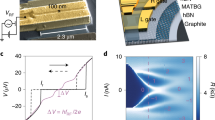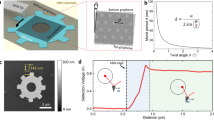Abstract
Recent developments in the technology of van der Waals heterostructures1,2 made from two-dimensional atomic crystals3,4 have already led to the observation of new physical phenomena, such as the metal–insulator transition5 and Coulomb drag6, and to the realization of functional devices, such as tunnel diodes7,8, tunnel transistors9,10 and photovoltaic sensors11. An unprecedented degree of control of the electronic properties is available not only by means of the selection of materials in the stack12, but also through the additional fine-tuning achievable by adjusting the built-in strain and relative orientation of the component layers13,14,15,16,17. Here we demonstrate how careful alignment of the crystallographic orientation of two graphene electrodes separated by a layer of hexagonal boron nitride in a transistor device can achieve resonant tunnelling with conservation of electron energy, momentum and, potentially, chirality. We show how the resonance peak and negative differential conductance in the device characteristics induce a tunable radiofrequency oscillatory current that has potential for future high-frequency technology.
This is a preview of subscription content, access via your institution
Access options
Subscribe to this journal
Receive 12 print issues and online access
$259.00 per year
only $21.58 per issue
Buy this article
- Purchase on Springer Link
- Instant access to full article PDF
Prices may be subject to local taxes which are calculated during checkout




Similar content being viewed by others
References
Geim, A. K. & Grigorieva, I. V. Van der Waals heterostructures. Nature 499, 419–425 (2013).
Novoselov, K. S. Nobel lecture: graphene: materials in the flatland. Rev. Mod. Phys. 83, 837–849 (2011).
Novoselov, K. S. et al. Electric field effect in atomically thin carbon films. Science 306, 666–669 (2004).
Novoselov, K. S. et al. Two-dimensional atomic crystals. Proc. Natl Acad. Sci. USA 102, 10451–10453 (2005).
Ponomarenko, L. A. et al. Tunable metal–insulator transition in double-layer graphene heterostructures. Nature Phys. 7, 958–961 (2011).
Gorbachev, R. V. et al. Strong Coulomb drag and broken symmetry in double-layer graphene. Nature Phys. 8, 896–901 (2012).
Lee, G. H. et al. Electron tunneling through atomically flat and ultrathin hexagonal boron nitride. Appl. Phys. Lett. 99, 243114 (2011).
Britnell, L. et al. Electron tunneling through ultrathin boron nitride crystalline barriers. Nano Lett. 12, 1707–1710 (2012).
Britnell, L. et al. Field-effect tunneling transistor based on vertical graphene heterostructures. Science 335, 947–950 (2012).
Georgiou, T. et al. Vertical field-effect transistor based on graphene–WS2 heterostructures for flexible and transparent electronics. Nature Nanotech. 8, 100–103 (2013).
Britnell, L. et al. Strong light–matter interactions in heterostructures of atomically thin films. Science 340, 1311–1314 (2013).
Woods, C. R. et al. Commensurate–incommensurate transition in graphene on hexagonal boron nitride. Nature Phys. 10, 451–456 (2014).
Xue, J. M. et al. Scanning tunnelling microscopy and spectroscopy of ultra-flat graphene on hexagonal boron nitride. Nature Mater. 10, 282–285 (2011).
Yankowitz, M. et al. Emergence of superlattice Dirac points in graphene on hexagonal boron nitride. Nature Phys. 8, 382–386 (2012).
Ponomarenko, L. A. et al. Cloning of Dirac fermions in graphene superlattices. Nature 497, 594–597 (2013).
Dean, C. R. et al. Hofstadter's butterfly and the fractal quantum Hall effect in moiré superlattices. Nature 497, 598–602 (2013).
Hunt, B. et al. Massive Dirac fermions and Hofstadter butterfly in a van der Waals heterostructure. Science 340, 1427–1430 (2013).
Yang, H. et al. Graphene barristor, a triode device with a gate-controlled Schottky barrier. Science 336, 1140–1143 (2012).
Haigh, S. J. et al. Cross-sectional imaging of individual layers and buried interfaces of graphene-based heterostructures and superlattices. Nature Mater. 11, 764–767 (2012).
Britnell, L. et al. Resonant tunnelling and negative differential conductance in graphene transistors. Nature Commun. 4, 1794 (2013).
Ponomarenko, L. A. et al. Field-effect control of tunneling barrier height by exploiting graphene's low density of states. J. Appl. Phys. 113, 136502 (2013).
Feenstra, R. M., Jena, D. & Gu, G. Single-particle tunneling in doped graphene–insulator–graphene junctions. J. Appl. Phys. 111, 043711 (2012).
de la Barrera, S. C., Gao, Q. & Feenstra, R. M. Theory of graphene–insulator–graphene tunnel junctions. J. Vac. Sci. Technol. B 32, 04E101 (2014).
Wallbank, J. R. Electronic Properties of Graphene Heterostructures with Hexagonal Crystals (Springer, 2014).
Brey, L. Coherent tunneling and negative differential conductivity in a graphene/h-BN/graphene heterostructure. Phys. Rev. Appl. 2, 014003 (2014).
Martin, J. et al. Observation of electron–hole puddles in graphene using a scanning single-electron transistor. Nature Phys. 4, 144–148 (2008).
Hayden, R. K. et al. Probing the hole dispersion curves of a quantum well using resonant magnetotunneling spectroscopy. Phys. Rev. Lett 66, 1749–1752 (1991).
Falko, V. I. & Meshkov, S. V. On resonant oscillations in current–voltage characteristics of double-barrier heterostructures. Semicond. Sci. Technol. 6, 196–200 (1991).
Dean, C. R. et al. Boron nitride substrates for high-quality graphene electronics. Nature Nanotech. 5, 722–726 (2010).
Sen, D., Novoselov, K. S., Reis, P. M. & Buehler, M. J. Tearing graphene sheets from adhesive substrates produces tapered nanoribbons. Small 6, 1108–1116 (2010).
Neubeck, S. et al. Direct determination of the crystallographic orientation of graphene edges by atomic resolution imaging. Appl. Phys. Lett. 97, 053110 (2010).
Eckmann, A. et al. Raman fingerprint of aligned graphene/h-BN superlattices. Nano Lett. 13, 5242–5246 (2013).
Mayorov, A. S. et al. Micrometer-scale ballistic transport in encapsulated graphene at room temperature. Nano Lett. 11, 2396–2399 (2011).
Acknowledgements
This work was supported by the European Research Council, EC-FET European Graphene Flagship, Engineering and Physical Sciences Research Council (UK), the Leverhulme Trust (UK), the Royal Society, the US Office of Naval Research, US Air Force Office of Scientific Research, US Army Research Office and RS-RFBR, grant numbers 14-02-00792 and 13-02-92612 (Russian Federation). Y-J.K. was supported by the Global Research Lab Program (2011-0021972) through the National Research Foundation of Korea funded by the Ministry of Science, ICT & Future, Korea.
Author information
Authors and Affiliations
Contributions
J.S.T., Y.C. and Y-J.K. fabricated devices, A.M. carried out measurements and analysed the results, J.R.W., M.T.G., T.M.F., V.I.F and L.E. provided theoretical modelling and interpretation, K.W. and T.T. provided hBN crystals, S.L.W., F.W. and C.R.W. performed atomic force microscopy and Raman measurements, R.V.G., V.E.M., S.V.M., M.J.Z., E.E.V. and O.M. helped with experiments and/or writing the paper, A.M., K.S.N. and L.E. wrote the manuscript. Sections 1 and 2 of the Supplementary Information were written by J.R.W. and V.I.F. All authors contributed to discussions.
Corresponding author
Ethics declarations
Competing interests
The authors declare no competing financial interests.
Supplementary information
Supplementary information
Supplementary Information (PDF 9928 kb)
Rights and permissions
About this article
Cite this article
Mishchenko, A., Tu, J., Cao, Y. et al. Twist-controlled resonant tunnelling in graphene/boron nitride/graphene heterostructures. Nature Nanotech 9, 808–813 (2014). https://doi.org/10.1038/nnano.2014.187
Received:
Accepted:
Published:
Issue Date:
DOI: https://doi.org/10.1038/nnano.2014.187
This article is cited by
-
Mixing of moiré-surface and bulk states in graphite
Nature (2023)
-
Anomalous optical response of graphene on hexagonal boron nitride substrates
Communications Physics (2023)
-
Design of ohmic contacts between Janus MoSSe and two-dimensional metals
NPG Asia Materials (2023)
-
Time, momentum, and energy resolved pump-probe tunneling spectroscopy of two-dimensional electron systems
Nature Communications (2023)
-
The quantum twisting microscope
Nature (2023)



